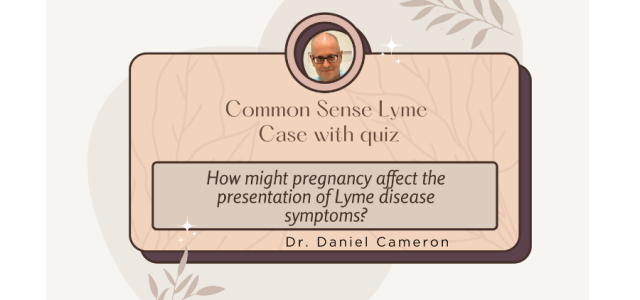Call for your appointment today 914-666-4665 | Mt. Kisco, New York

A 23-year-old woman from Brooklyn, NY, presented to her primary care physician with bilateral knee swelling and pain three days after delivering a healthy baby girl. She rated the pain as 8 out of 10 in severity and reported that it worsened with walking.
Case
The patient recalled experiencing similar knee pain for two days during the sixth month of her pregnancy but had not sought medical attention at that time.
During her pregnancy, she had taken several trips to wooded areas in upstate New York, where Lyme disease is endemic. She denied having a known tick bite or noticing an erythema migrans rash.
Testing for Lyme disease revealed a positive Western blot with 9 out of 10 IgG reactive bands, including: 18, 23, 28, 33, 41, 43, 58, 66, and 93 kDa bands.
These results confirmed the diagnosis of Lyme disease, indicating prior exposure to Borrelia burgdorferi, the bacterium responsible for Lyme disease.
The patient was treated successfully with a 3-week course of doxycycline, which resolved her symptoms. Her newborn daughter was symptom-free at birth and continued to remain asymptomatic throughout early childhood and beyond.
Four Key Discussion Points
1. Asymptomatic Lyme Disease During Pregnancy
This case suggests that Lyme disease can remain asymptomatic or minimally symptomatic during pregnancy. The woman experienced only a brief episode of knee pain during her pregnancy, which resolved spontaneously and did not prompt further evaluation. Her symptoms reappeared abruptly in the postpartum period, possibly due to immunological and hormonal changes associated with childbirth.
2. No Evidence of Congenital Lyme Disease
The authors reported no evidence of congenital or perinatal transmission of Borrelia burgdorferi in this case. The newborn showed no signs of Lyme disease at birth or during early childhood. However, the authors did not address whether additional research is warranted to better understand and ease parental concerns regarding congenital Lyme disease.
3. Diagnosis Based on Clinical History and Testing
The diagnosis was supported by Western blot testing, which demonstrated multiple reactive bands specific to Lyme disease. Notably, the absence of a known tick bite or erythema migrans rash underscores the importance of considering Lyme disease in patients with relevant symptoms and exposure history, even when hallmark features are missing—especially in endemic regions.
4. Effective Treatment with Doxycycline
A 3-week course of doxycycline led to full resolution of the patient’s symptoms. The authors did not explore alternative treatment options that might be considered if the patient had remained symptomatic following initial therapy.
Conclusion
This case, reported by Pavia et al. in Case Reports in Infectious Diseases, highlights the need to maintain a high index of suspicion for Lyme disease in postpartum patients presenting with unexplained joint pain or swelling, particularly those who live in or have traveled to endemic areas. Early diagnosis and prompt treatment are essential to avoid long-term complications and support rapid recovery.
Leave your questions or comments below.
References
Pavia CS, Wormser GP, et al. An Unusual Case of Serologically Confirmed Post-Partum Lyme Disease Following an Asymptomatic Borrelia burgdorferi Infection Acquired during Pregnancy and Lacking Vertical Transmission in Utero. Case Reports in Infectious Diseases. 2018.



